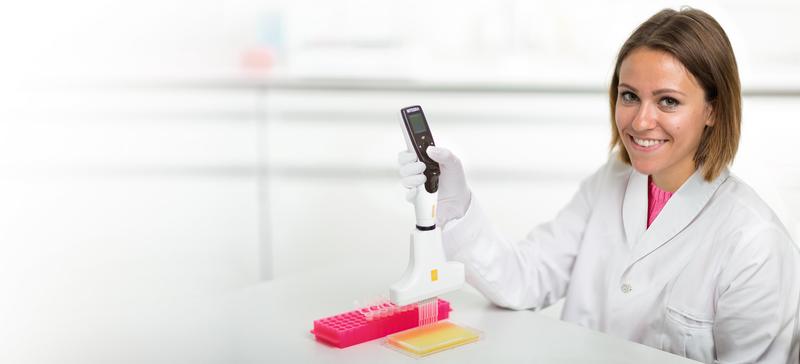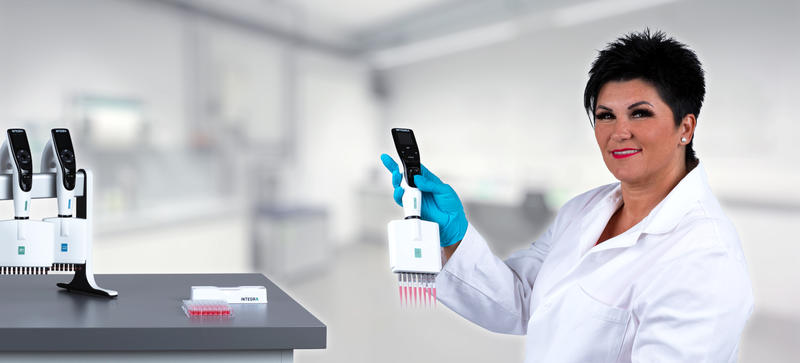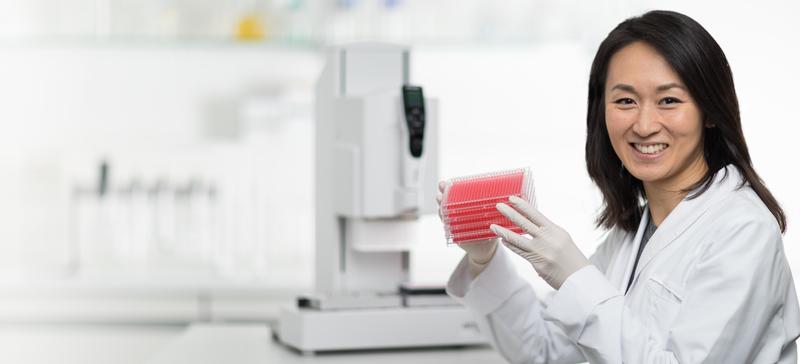-
Automated Minimum Inhibitory Concentration Testing
Rapid and accurate determination of MIC by automation of serial dilution steps on the ASSIST PLUS
Antibiotic resistance is a major threat to public health worldwide. One of the causes of antibiotic resistance is the overuse and misuse of antibiotics in healthcare and agriculture. One of the most important approaches used to define the effectiveness of an antimicrobial compound is to determine the minimum inhibitory concentration (MIC). Serial dilution of a compound is performed by mixing it with liquid growth medium, followed by the addition of a bacterium. Bacterial growth is then measured in the presence of different compound concentrations. The MIC is defined as the lowest concentration of an antimicrobial compound that inhibits the growth of the bacterium. Automating the transfer and mixing steps with the ASSIST PLUS pipetting robot enables serial dilutions to be performed faster and more reproducibly. Pipetting heights, speeds and mixing parameters are consistent across all dilutions, and the potential ergonomic hazards of manual pipetting are avoided.
-
Table of contents
Antibiotic resistance is a major threat to public health worldwide. One of the causes of antibiotic resistance is the overuse and misuse of antibiotics in healthcare and agriculture. One of the most important approaches used to define the effectiveness of an antimicrobial compound is to determine the minimum inhibitory concentration (MIC). Serial dilution of a compound is performed by mixing it with liquid growth medium, followed by the addition of a bacterium. Bacterial growth is then measured in the presence of different compound concentrations. The MIC is defined as the lowest concentration of an antimicrobial compound that inhibits the growth of the bacterium. Automating the transfer and mixing steps with the ASSIST PLUS pipetting robot enables serial dilutions to be performed faster and more reproducibly. Pipetting heights, speeds and mixing parameters are consistent across all dilutions, and the potential ergonomic hazards of manual pipetting are avoided.
Key benefits
- Serial dilutions are laborious and error prone, but with the ASSIST PLUS, it's a walk in the park. The user does not lose track of the pipetting scheme, their hand does not tire through manual pipetting, and repetitive strain injuries do not develop. This is because the ASSIST PLUS, together with the VOYAGER adjustable tip spacing pipette, does the majority of the work. The user just has to define the key parameters for the serial dilution, such as the volumes and the mixing steps.
- Automating MIC determination on the ASSIST PLUS increases reproducibility by providing optimal and consistent pipetting heights, angles and immersion depths, as well as automating tip exchange.
- With the VOYAGER adjustable tip spacing pipette, compounds and bacterial inoculum stored in tubes can be transferred to the dilution plate eight times faster than with a single channel pipette.
- Changes in volumes, mixing cycles or labware can be effortlessly adjusted in the easy-to-use VIALAB software.
- The whole workflow can be fully automated in just one program, providing a complete walk-away solution that frees up highly valuable time.
Overview: How to automate MIC testing
The ASSIST PLUS pipetting robot and an 8 channel VOYAGER 125 μl adjustable tip spacing electronic pipette with 125 μl Sterile, Filter GRIPTIPS® can be used for the automated determination of MICs. In this microbroth dilution assay, eight different antibiotics were tested across a range of 10x twofold dilutions (doubling dilutions) with one bacterial strain in a single 96 well plate (Figure 1). Growth controls (growth media and bacterial inoculum) and sterility controls (growth media only) were also included. The pipetting program was generated using the VIALAB software.
Before starting the MIC test, the antimicrobial compound should be dissolved and diluted to the appropriate starting concentration. The bacterial inoculum should derive from morphologically similar colonies cultured overnight, and have a concentration of 5x105 CFU (colony forming units)/ml.
Downloads: App note, protocols and reports for automated MIC testing with the ASSIST PLUS
Here you can download the complete protocols and reports used in this application and use them on your ASSIST PLUS. The protocol can be customized with the VIALAB software.
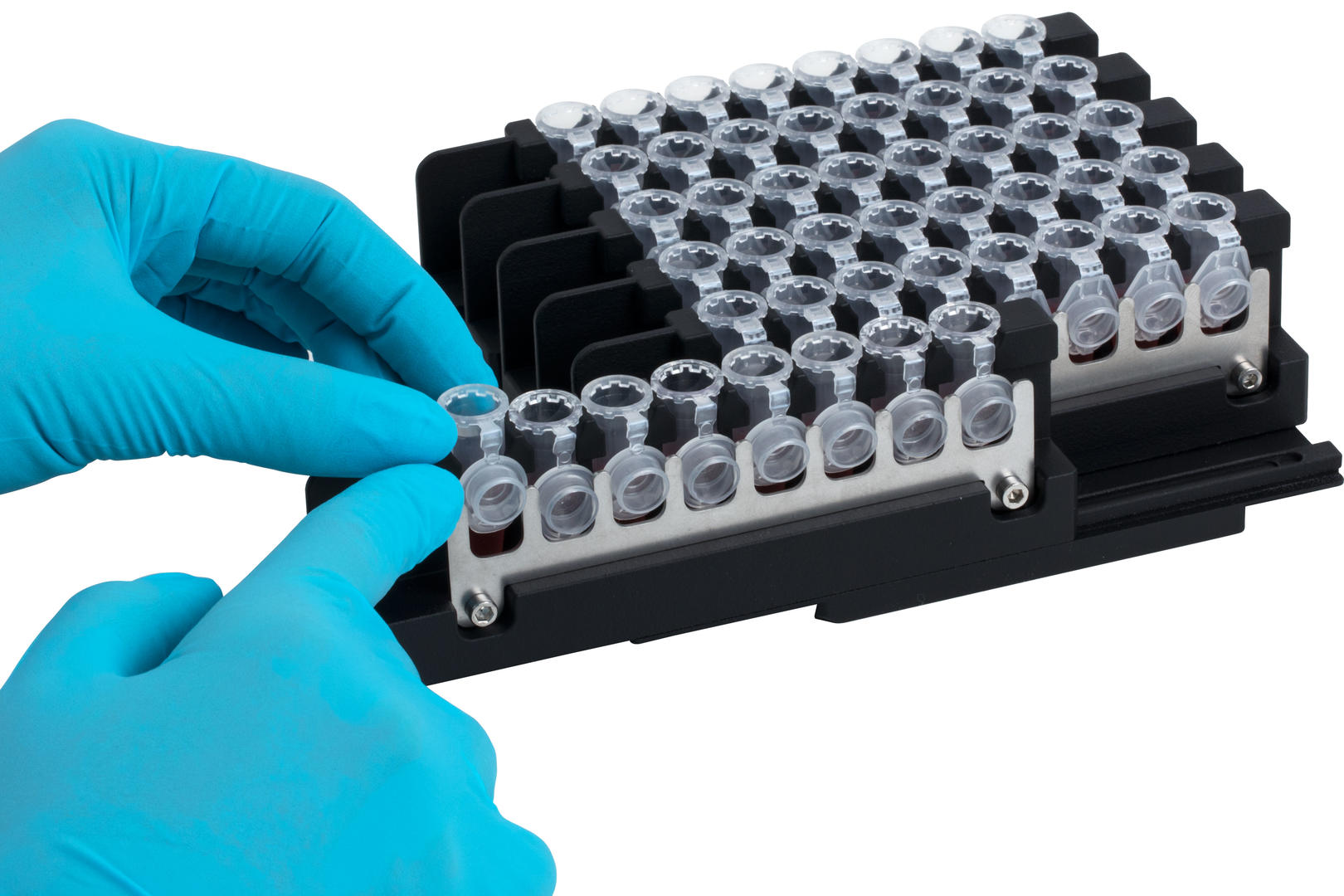
Experimental set-up: Automated MIC assay
|
Deck position A: |
10 ml multichannel reagent reservoir with SureFlo™ anti-sealing array. |
|
Deck position B: |
INTEGRA rack for 1.5/2 ml microcentrifuge tubes (Figure 2) with two sliders. |
| Deck position C: |
96 well, flat bottom plate (Greiner Bio-One International). |
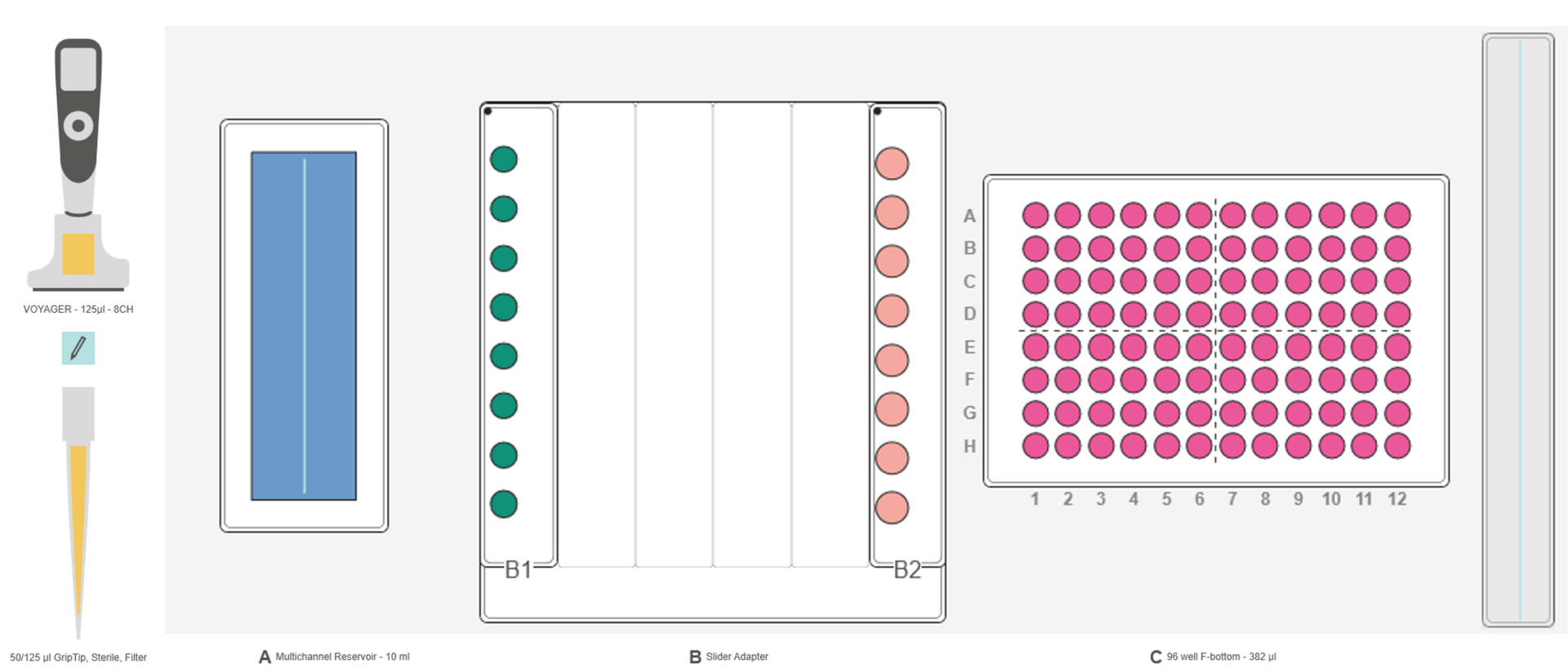
Step-by-step procedure
1. Add the medium
Addition of bacterial growth medium to the sample, sterility, and growth control wells
Fill a 10 ml multichannel reservoir with 8 ml of fresh bacterial growth medium and load it on deck position A. Place the INTEGRA rack on deck position B. Fill the 0.5 ml screw cap tubes with eight different antimicrobial compounds to be tested against the bacterial strain (Figure 3, green). Fill the 1.5 ml reaction tubes with the bacterial inoculum (Figure 3, light pink). Place the 96 well flat bottom plate on deck position C (Figure 3, magenta).
Select and run the VIALAB program 'MIC_Assay' on the VOYAGER pipette. The pipette transfers 50 μl bacterial growth medium to columns 2 to 11 of the microplate. The 5 μl post-dispense ensures precise pipetting, even if the growth medium tends to form bubbles during pipetting. In the next step, the pipette transfers 100 μl of bacterial growth medium to column 12 of the microplate. The wells in this column will be the sterility controls, containing only bacterial growth medium.
This step uses a single set of sterile filter tips, as it only involves transfer of sterile medium to an empty, sterile plate.
Tip:
- The workflow parameters can be easily modified in VIALAB software. If the samples and reagents are in a different labware format, this can be set up quickly.
2. Serial dilution
Twofold serial dilution of the antimicrobial compound
The pipette transfers 100 μl of the antimicrobial compounds to the wells of column 1, then performs a twofold serial dilution (Figure 1), starting from column 1 (highest concentration) and finishing at column 10 (lowest concentration = 1:512). The pipette aspirates a 50 μl volume from the wells of one column, then dispenses it into the wells of the next column. Fully mixing the components is crucial in serial dilution, so the program includes an optimized mixing step with three mixing cycles before aspirating and after dispensing. The last aspirate stays in the tip, and is subsequently discarded to waste with the tip. This ensures that there is an equal volume in every well of the serial dilution.
Tips:
- The mixing volume (100 μl) in the serial dilution is set higher than the transfer volume (50 μl), resulting in a homogeneous mix without increasing the assay time significantly.
- Productivity can be significantly increased by using the VOYAGER adjustable tip spacing pipette when transferring compounds from tubes to the MIC assay plate.
3. Add the bacterium
Addition of the bacterial inoculum
In this step, the ASSIST PLUS pipetting robot transfers 50 μl of bacterial inoculum to the wells of columns 1 to 11. When determining the MIC, it is very important that the concentration of the bacterial inoculum is the same in every well, to ensure consistent and reproducible results. An identical inoculum concentration is ensured through the implementation of mixing steps before every aspiration and after every dispense.
Tip:
- Using disposable sterile filter tips allows contamination-free processing.
4. Incubation and plate reading
Incubation for bacterial growth and results read-out
The ASSIST PLUS pipetting robot informs the user to incubate the 96 well plate, then prompts them to read the results with a microplate reader. The optical density is measured and corrected using the blank wells of the sterility control, and the bacterial growth is determined. For each compound, the lowest concentration without bacterial growth is defined as the MIC (Figure 4).
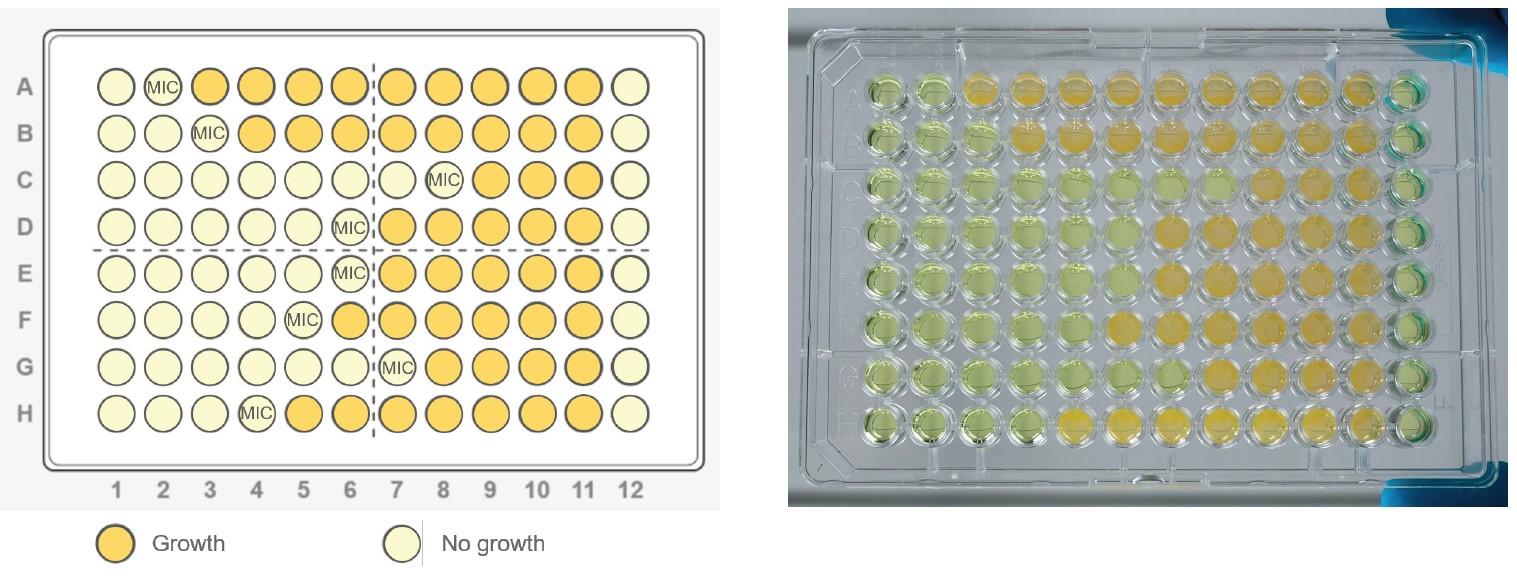
Remarks
VIALAB software:
The VIALAB programs can be easily adapted to your specific labware and protocols, for instance, when partial plates are needed.
Partial plates:
Programs can be adapted at any time to a different number of samples, giving laboratories total flexibility to meet current and future demands.
Conclusion
- Determination of the minimum inhibitory concentration is a very important and widely used approach in both antibiotic development and routine antimicrobial susceptibility testing by clinical microbiology laboratories.
- Performing MIC testing with the ASSIST PLUS pipetting robot and VOYAGER adjustable tip spacing pipette provides a fully automated solution, with the flexibility to adapt to different labware formats and user needs.
- Serial dilutions are error-prone processes, but the reproducibility of MIC testing can be increased significantly with the ASSIST PLUS.
- Contamination can be avoided by automated tip exchange and the use of sterile, filtered disposable tips.
- The potential ergonomic hazard of prolonged pipetting during serial dilution steps can be avoided by fully automating MIC testing.
Ask our expert. Leave a comment!
Write us if you have any questions regarding the application note or one of our instruments.
Any questions? I'm happy to help!
Instruments and accessories
ASSIST PLUS, Pipetting Robot
INTEGRA has developed the ASSIST PLUS pipetting robot to streamline routine pipetting tasks at an affordable price. Using INTEGRA electronic multichannel pipettes, the system:
- automates pipetting tasks,
- eliminates physical strain and
- ensures superior reproducibility and
- error free pipetting.
Part No. 4505
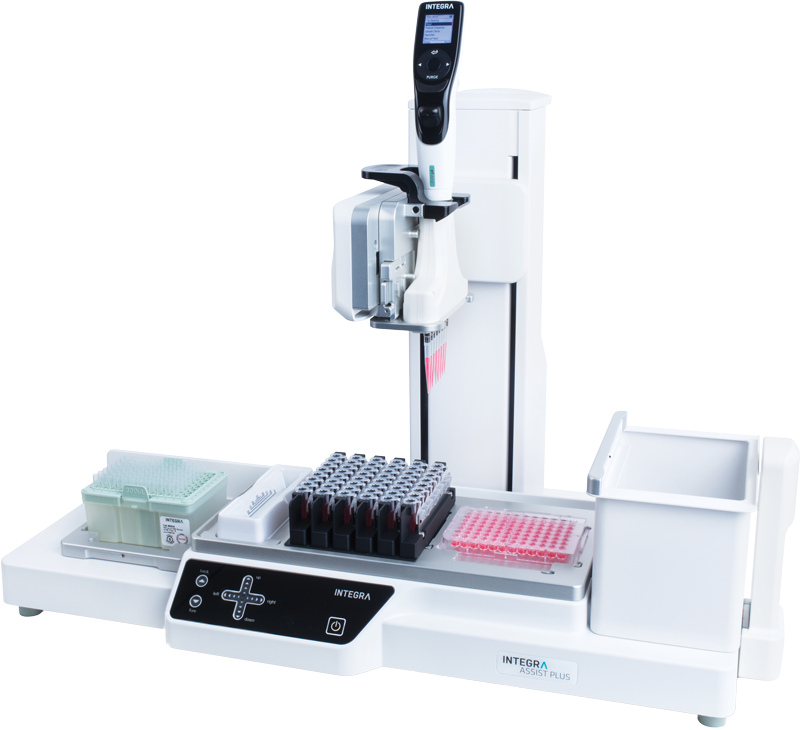
VOYAGER, 8 Channel, 125 µl
VOYAGER pipettes allow the tip spacing to expand anywhere between 4.5 mm and 33 mm at the push of a button.
- Single handed operation leaves the other hand free to handle labware.
- On the fly access to up to 3 user-defined tip spacings.
- These user defined tip spacings are saved. No need to memorize spacings of different labware formats.
Part No. 4722
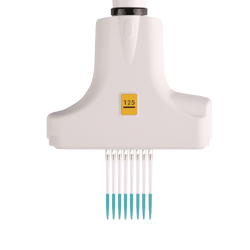
Rack for 1.5/2 ml microcentrifuge tubes
Hold up to 48 tubes on removable carriers for easy loading and storage.
Part No. 4540
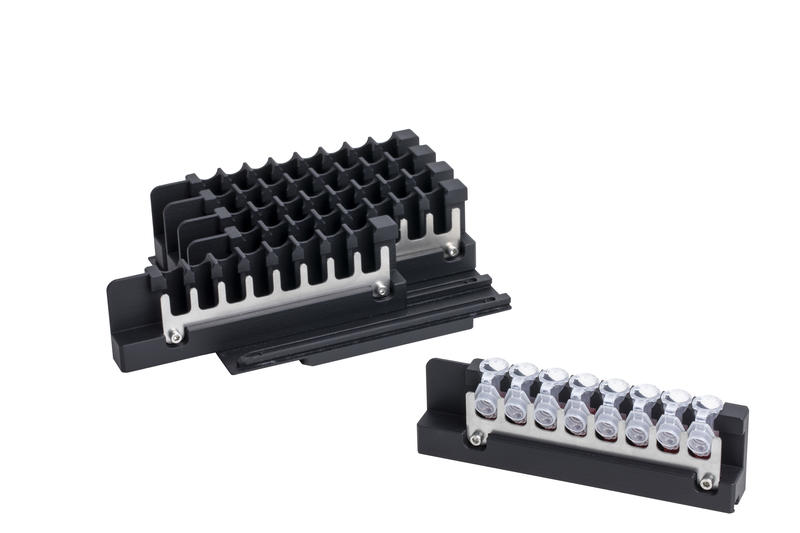
GRIPTIP, 125 µl, Sterile, Filter
GRIPTIPS® pipette tips perfectly match the multi-lobe tip fitting, snapping firmly on during loading. This guarantees a perfect seal on every tip, preventing them from loosening, leaking or completely falling off. All tips are precisely aligned horizontally, enabling accurate touch-offs, even when pipetting with 384 tips.
Part No. 4425
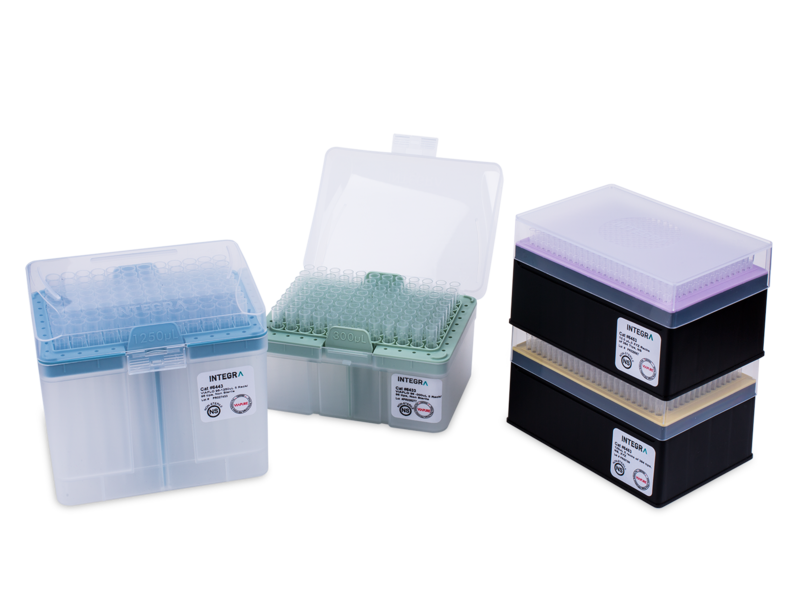
Multichannel Reagent Reservoir, 10 ml, PS
- SureFlo™ anti-sealing array prevents pipette tip seal off which can cause liquid to pop into the tip, filter or even the pipette itself
- Unique surface treatment spreads liquid evenly offering even lower dead volumes
- Reusable base with bold, crisp, clearly visible graduation markings
- Nest inside each other, making it possible to get twice as many reservoirs in half the space of other products on the market
- Reducing inventory space requirements and shipping costs
- Available as crystal clear polystyrene reservoirs or polypropylene reservoirs for improved chemical compatibility
Part No. 4370, 4372
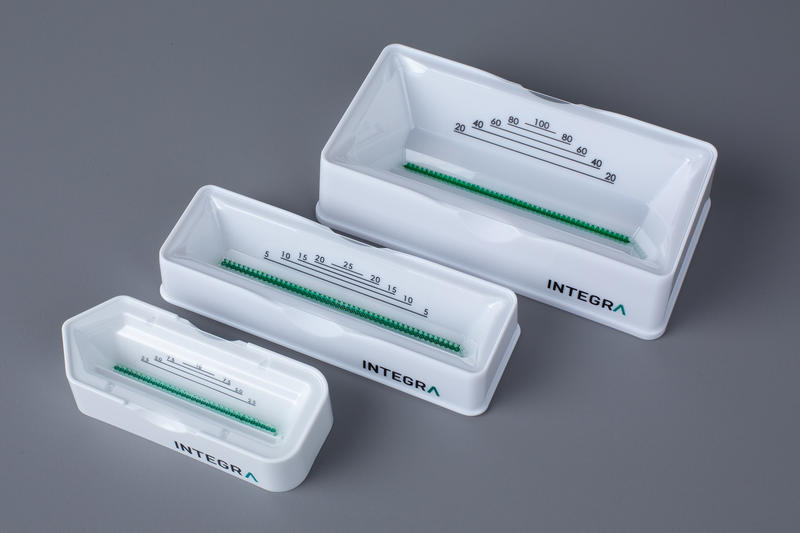
STARLAB: Screw Cap Tube, 0.5 ml, Plain, Conical, Natural
Polypropylene screw cap tubes made from 100% medical grade polypropylene. Suitable for many applications from sample storage in the gas phase of liquid nitrogen to freezer, through boiling to autoclave (121 ºC). Available with or without graduations, the graduated versions are marked at every 100 µl to provide easy sample estimation. Offered with either skirted or conical bases. Routinely tested to 20,000 x g. Caps are available separately; all tubes and caps are autoclavable. Certified RNase, DNase and DNA free.
Part No. E1405-2130
Source: Supplier Website
Greiner Bio-One: Reaction Tube, 1.5 ml, PP, Natural, Attached Cap
- Free of detectable DNase, RNase, human DNA
- Non-Pyrogenic
- High chemical and temperature resistance
- Volume: 1.5 ml
- With graduation and attached cap
- Suitable for Eppendorf
Part No. 616201
Source: Website Supplier
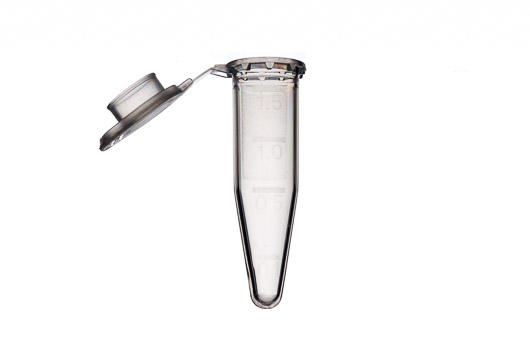
Greiner Bio-One: 96 Well Microplate, PS, F-Bottom
SAPPHIRE MICROPLATE, 96 WELL, PP, FOR RT PCR, WHITE, HALF-SKIRT, FOR LIGHT CYCLER, 10 PCS./BOX
Source: Website Greiner Bio One
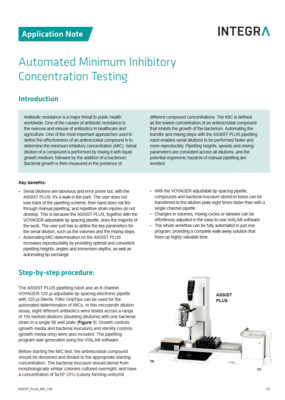
Customer’s voice
I am incredibly impressed with the hardware, software, and support of this device. The Assist Plus made pipetting large numbers (hundreds to thousands) of small volume reference standards a much easier process, both in terms of ensuring precise volumes every time and in terms of strain on my back/hands! Swapping consumables and vials was all I had to do once the program started. The ViaLab software used to program the Assist Plus was easy to understand and use, requiring no programming knowledge. It was also highly customizable to meet specific needs and use specific consumables. Prior to use, a technician from Integra stopped by to ensure the machine was calibrated properly after installation, and also answered several questions we had about operation. Great support/service. (Review published on Select Science)

